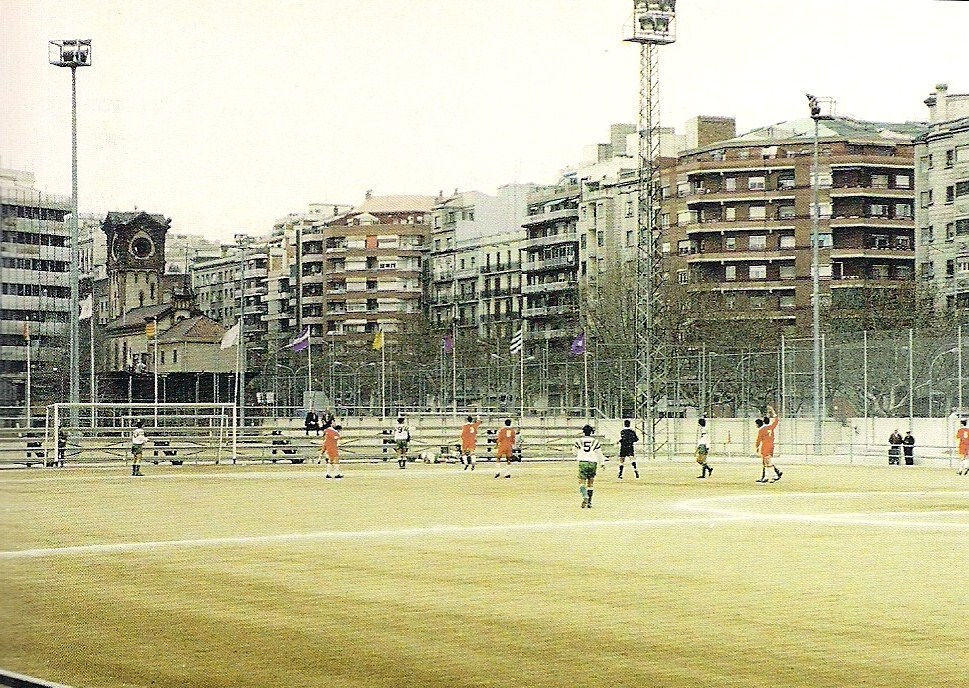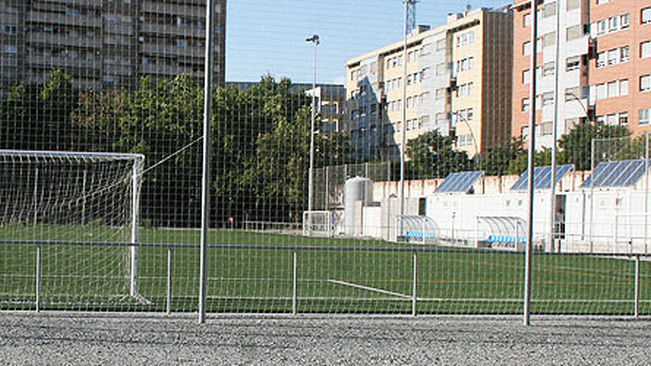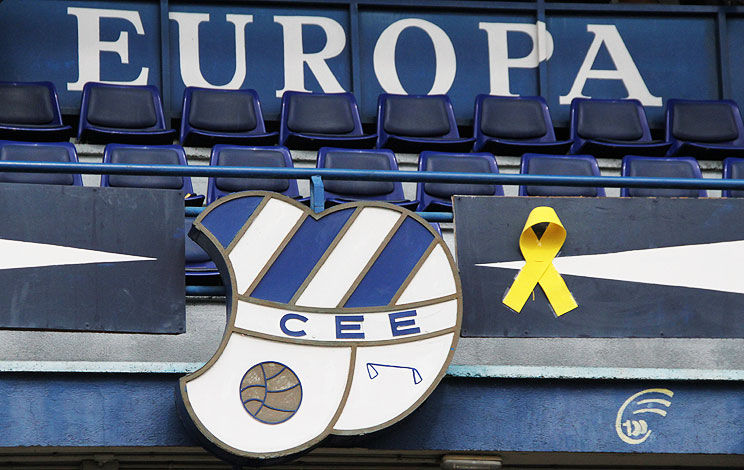Groundhopping In Catalonia's Tercera Divisió: A guide
- Cody

- Jul 21, 2018
- 5 min read
Updated: Jul 29, 2018

Barcelona, whether it likes it or not, has remained one of the most visited cities in Europe. After having lived there for two years, I fully support the perception of Barcelona being a lovely place to spend your time. Generally pleasant weather, fine cuisine, a variety of architecture, and a decent, if not crowded, beach - good enough for me. Groundhoppers probably immediately associate the Catalan capital with the iconic Camp Nou. However, for those on a budget or those looking to catch a lower-league match, Barcelona hosts six clubs that play in Spain’s fourth division. Several of these clubs are historic, and their stadiums are often situated in the middle of the neighborhoods that the clubs represent. Each ground remains a source of pride for residents who feel closer to their barri than to the city of Barcelona. In honor of the start of the Tercera Divisió Catalana, here is our look at four Barcelona-based grounds.
Nou Sardenya
Club Esportiu Europa started out as an important club in Spain, being a founding member of the first Spanish top-flight alongside giants FC Barcelona and RCD Espanyol. The club represents the neighborhood of Gracia, a former village, which was once separate from Barcelona. Now, Gracia sits in the heart of the city and retains a small-town-feel whilst being just a few metro stops from the city center. Europa, founded in 1907, built the stadium after the Spanish Civil War, as the previous ground had been taken apart for scrap. The Nou Sardenya first opened in 1940 and, despite a much-needed renovation in 1995, very much retains the feel of a classic, neighborhood stadium. The ground holds up to 8,000 people, with one covered grandstand and three sides of open terracing. The ultras, a small group of about 40 people on average, set themselves up in the South Stand, with the majority of spectators taking shelter under the grandstand. The beautiful thing about the ground is the variety of people that show up to matches. It truly is a neighborhood club, with elderly, lifelong members sitting next to their grandkids, mixed with a group of younger fans and ultras.

Entrance to a league match costs 10 euro for non-members, not the cheapest price you’ll find in Spain’s fourth division. The ultras have, however, been pushing for more affordable tickets. The yellow metro line and either stops Joanic or Alfons X leave you within a short walk of the stadium. Grab yourself a cold beer - 2 euros a piece - and enjoy the sunshine and a humble match of football.
Narcis Sala

Venture a bit farther from the city center and you may find yourself in another former poble, a place that still maintains its local identity - Sant Andreu. It’s a neighborhood that touches the edge of the city’s borders. The Narcis Sala hosts Unio Esportiva Sant Andreu, a well-supported fourth-division club, which last season was close to escaping Spain’s convoluted play-off system and earning promotion to the Segunda B. The ground itself feels relatively large for fourth-division club, and the club then added a cover to the grandstand this past season. UESA supporters are capable of creating one of the best atmospheres in Catalunya’s Tercera Divisió, backed by a group of anti-fascist, left-wing ultras known as the Desperdicis. The group base themselves in the North Stand of the Narcis Sala and have gone from strength to strength in recent seasons. Depending on the opponent, you might find anywhere from 50 to a couple of hundred people in the North Stand, certainly nothing to scoff at for a fourth-division, local side.

The stadium is just outside of the Onze de Septiembre metro station (Line 9 or 10), making it an easy ground to reach. The club charge 10 euros for a seat in the grandstand and just 5 euros per entrance to the North Stand in a push to capitalize on the rise in attendance and atmosphere that they’ve seen over the past few seasons. In fact, if you’ll be in Barcelona for a while, you’d be wise to pick up a season membership card which offers entrance to each league home match in the North Stand for just 30 euros - not bad at all.
Camp Municipal de la Verneda

CE Jupiter represent the neighborhood of Poble Nou in the Sant Marti district of Barcelona. Poble Nou has historically been the industrial center of Barcelona and Catalonia, but recently many of the former factories have been transformed into trendier dwellings. The neighborhood has become increasingly popular with tourists due to its proximity to the beach and the city center. Having spent the last season in the Primera Catalana, Jupiter will celebrate their 110th season in their usual place in the Tercera division. The neighborhood's working-class roots meant that the club was founded and supported by many anarchists before the Spanish Civil War. Twice the Spanish government forced the club to change its badge, which is a blue star sitting above the red and yellow stripes of the senyera, to something less “Catalan”. Thankfully, it has been able to use its original badge since the 90’s.

The club’s former ground, Lope de Vega in Poble Nou, was even used to store the weapons for the anarchists workers fighting against the fascist forces and was a central point for anarchist meetings after Franco’s coup d'état. The main set of ultras, Reducte GrisGrana, have kept this rebellious spirit alive, while leaning to the political left (and they’re some great people, on top of that). Jupiter’s current ground is lovely, with a partially-covered grandstand and three sides of terracing for those who prefer to stand. Easily accessible by metro, the Camp de la Verneda sits just a few blocks from either the purple-line (L2) Sant Marti stop or the Besos stop on the yellow-line (L4). We're still waiting on the pricing for the upcoming season, but Jupiter has always seemed to help the local supporters with affordable pricing, so you can probably bet on something from 5 to as much as 10 euros for a matchday ticket.
Municpal de l'Energia

Promoted at the end of the 17/18 season after losing out in the previous season’s playoff to Reus B, UE Sants enters the Tercera Divisio to offer yet another Barcelona derby. Founded in 1922, Sants is another historic Catalan club reinforcing the rich, neighborhood-based club culture in Barcelona. Like Gracia, Sant Andreu, and Poble Nou, Sants is made up of the old village, consisting of narrows streets and small, enclosed squares, and the newer, taller buildings surrounding it. The Tercera is the highest division that the club has ever played in, and they will no doubt be hoping to establish themselves as regulars and potentially push on to the Segunda B.

Perhaps the most noteworthy part of Sants ground isn’t where they play but where they can’t play. The club has played at nine different home grounds over the course of their 96 year history, including a two-year stint at CE Europa’s Nou Sardenya. The club has found itself in a state of permanent exile, often times due to financial or bureaucratic reasons. Of all of their grounds, the club’s “home” is La Magoria, where they played from 1984 to 2009. The club was unable to afford the implementation of an artificial pitch, among other obligatory changes, and were forced the leave the ground. The club has spent the last few years at the Municipal de l’Energia. which sits in l’Hospitalet outside of the Sants neighborhood and, in reality, is little more than a pitch with railing to separate the supporters. The club has brought in some temporary seating for those that need it, but your best bet is to grab a beer and find a spot along the rail. The club has been desperately trying to raise funds from members and Sants residents to be able to remodel La Magoria and make the long-awaited return, but, as with so many lower-division clubs, the money has proven hard to come by. Hopefully, if and when you visit, the club will be back in the one place that it has called home.





Comments